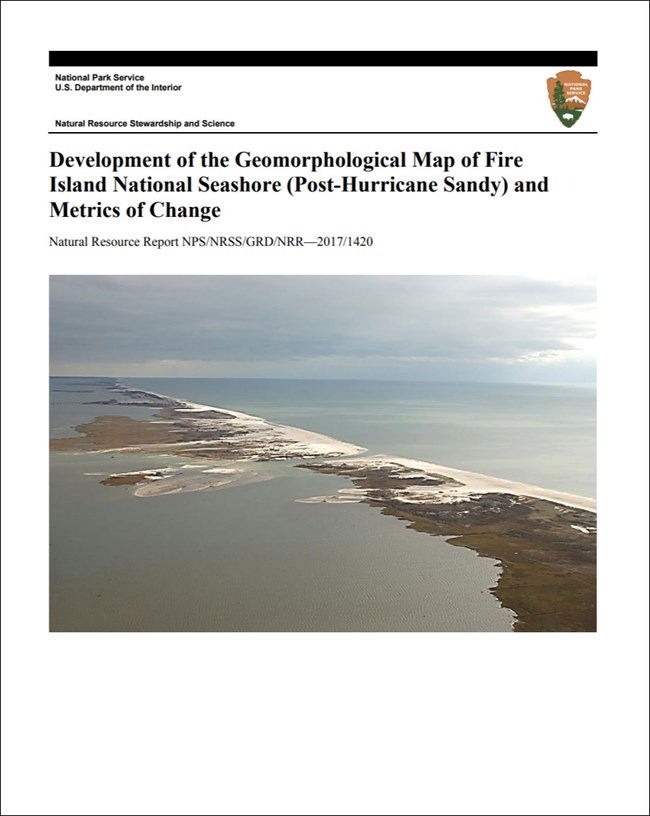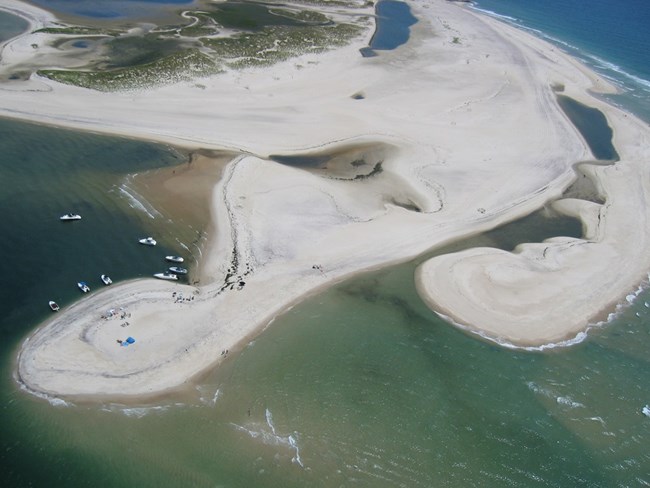Last updated: June 17, 2024
Article
NPS Geodiversity Atlas—Fire Island National Seashore, New York
Geodiversity refers to the full variety of natural geologic (rocks, minerals, sediments, fossils, landforms, and physical processes) and soil resources and processes that occur in the park. A product of the Geologic Resources Inventory, the NPS Geodiversity Atlas delivers information in support of education, Geoconservation, and integrated management of living (biotic) and non-living (abiotic) components of the ecosystem.

Introduction
Fire Island National Seashore (FIIS) encompasses a 42 km (26 mi) section of Fire Island, a barrier island separated from Long Island by the Great South Bay in Suffolk County, New York. Established on September 11, 1984, FIIS protects approximately 7,923 hectares (19,580 acres) of cultural and natural resources that include sandy beaches, dunes, intertidal scrub, maritime forest, wetlands, the Fire Island Lighthouse, and the William Floyd Estate. The William Floyd Estate, once home to the signer of the Declaration of Independence, was authorized as an addition to FIIS in 1978 and preserves 250 years of history. Visitors to FIIS can explore a diverse range of recreational activities that include swimming, boating, beachcombing, birdwatching, fishing, camping, hiking, stargazing, and wildlife gazing.
Geologic Setting
Situated in the Atlantic Coastal Plain physiographic province, the geology of FIIS is dominated by young, unconsolidated, and partially consolidated sediments of gravel, sand, silt, and mud. Much of the barrier island is composed of recent dune sand, beach deposits, and swamp and marsh deposits. The oldest geologic units in FIIS are represented by Pleistocene-age (~30,000 years old) outwash deposits from ice along the Ronkonkoma Drift with outcrops of the Manhasset Formation located at the William Floyd Estate on the mainland of Long Island (Frye et al. 1968; Sirkin 1982). Dynamic coastal processes such as wind, waves, tides, and human interaction, in combination with the geologic foundation of FIIS, help control the shape and distribution of the diverse habitats that make up the Seashore.
Regional Geology
Fire Island National Seashore is a part of the Embayed section of the Coastal Plain Physiographic Province and shares its geologic history and some characteristic geologic formations with a region that extends well beyond park boundaries.
- Scoping summaries are records of scoping meetings where NPS staff and local geologists determined the park’s geologic mapping plan and what content should be included in the report.
- Digital geologic maps include files for viewing in GIS software, a guide to using the data, and a document with ancillary map information. Newer products also include data viewable in Google Earth and online map services.
- Reports use the maps to discuss the park’s setting and significance, notable geologic features and processes, geologic resource management issues, and geologic history.
- Posters are a static view of the GIS data in PDF format. Newer posters include aerial imagery or shaded relief and other park information. They are also included with the reports.
- Projects list basic information about the program and all products available for a park.
Source: NPS DataStore Saved Search 2850. To search for additional information, visit the NPS DataStore.
A NPS Soil Resources Inventory project has been completed for Fire Island National Seashore and can be found on the NPS Data Store.
Source: NPS DataStore Saved Search 2917. To search for additional information, visit the NPS DataStore.

Related Links
Related Articles
Fire Island National Seashore
National Park Service Geodiversity Atlas
The servicewide Geodiversity Atlas provides information on geoheritage and geodiversity resources and values within the National Park System. This information supports science-based geoconservation and interpretation in the NPS, as well as STEM education in schools, museums, and field camps. The NPS Geologic Resources Division and many parks work with National and International geoconservation communities to ensure that NPS abiotic resources are managed using the highest standards and best practices available.
